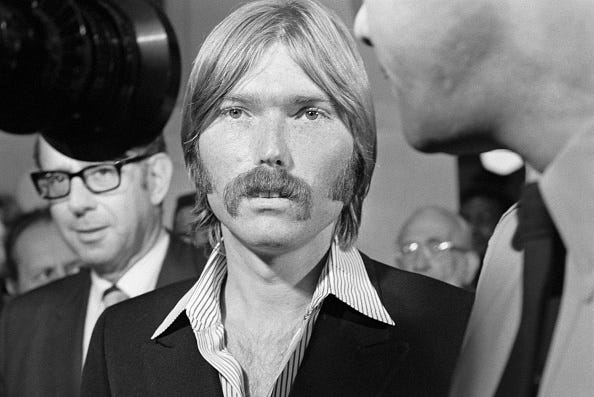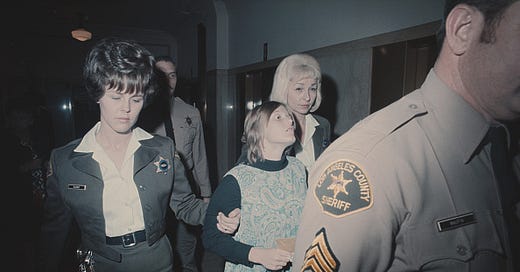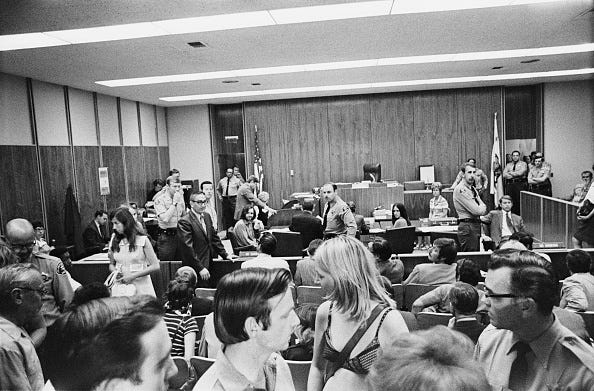Californians of a certain age know the details by heart: How Charles Manson’s followers, on his command, slaughtered seven people over two nights in August 1969. First the actress Sharon Tate, who was eight and a half months pregnant, and four others at her home in Benedict Canyon. Then Leno and Rosemary LaBianca at their home in Los Feliz. Manson ordered his family to write variations of the word “pig” in blood on walls—to frame the Black Panthers and incite an apocalyptic race war, which he called Helter Skelter, after the Beatles song.
This is the official story, given to us by Vincent Bugliosi, the lead prosecutor in the Manson case, first in court and then in “Helter Skelter,” published in 1974, which is still the best-selling true-crime book of all time.
Five decades after the book was published, and five decades after Bugliosi won convictions of Manson and his followers, that official story is coming apart. A drip-drip-drip of books, media reports and at least one docuseries have suggested that Bugliosi’s version is at best incomplete and at worst a gross distortion of the truth. Yes, the family killed the victims, and yes, Manson made them do it—but no, not for Helter Skelter.
The journalist Tom O’Neill makes the most exhaustive case for rethinking the murders in “Chaos: Charles Manson, the C.I.A., and the Secret History of the Sixties.” It’s a doorstop of a book, the product of twenty years of research, begun in 1999 when Premiere magazine asked him to write a piece for the thirtieth anniversary of the crimes. The assignment seemed straightforward enough. But within weeks, O’Neill started finding holes. Epic story short: He never filed, Premiere no longer exists, and O’Neill is still trying to get to the end of the Manson-murder labyrinth.
“Chaos” doesn’t establish what did happen. O’Neill and his co-author, Dan Piepenbring, may write a second book. But it lays out so many distortions, omissions, procedural lapses, acts of official misconduct and staggeringly weird twists in the story that by the end it becomes impossible to take Bugliosi’s word on much of anything.
“Chaos” spent five months on the New York Times best-seller list for paperback nonfiction last year. Errol Morris has adapted the book into a new documentary, which will premiere at MOMA on March 6 and be released on Netflix on March 7. And Quentin Tarantino, who knows a little something about the Manson-family murders, recently said it’s the best of all the books written on the subject: “Throw the rest of them away in the fucking trash.”
The unraveling began with a tip from Bugliosi himself. At the end of a long interview in 1999, O’Neill asked Bugliosi if he could share anything about the case that had never been reported before. After a long silence, Bugliosi told O’Neill to turn off his recorder.
Bugliosi then brought up a videotape found at the Cielo Drive house in the first few days after the murders. In “Helter Skelter,” Bugliosi said this videotape showed Sharon Tate having sex with her husband, the director Roman Polanski, and that shortly after finding it, police returned the tape to the house. “With a certain delicacy, the tape was not booked into evidence but was returned to the loft where it had been found,” he wrote.
In fact, Bugliosi informed O’Neill, the videotape depicted Tate being forced to have sex with two men while Polanksi filmed. Police returned the tape to the house because Bugliosi instructed them to, he told O’Neill. “Put it back where you found it,” Bugliosi said he told the detectives. “Roman has suffered enough.”
As O’Neill continued to report what he thought would be a magazine piece, he ruminated on Bugliosi’s revelation. The more he thought about it, the more questions it raised. Wasn’t this rape? And, if true, why didn’t the discovery of such a tape raise Polanski’s profile as a suspect?
Moreover, according to “Helter Skelter,” Bugliosi had nothing to do with the murder investigation until he was assigned the case in November 1969. If his disclosure to O’Neill was accurate, Bugliosi was involved in the investigation months earlier than he had claimed in his bestselling book.
“Chaos” goes on like this, pulling thread after thread, until it breaks your brain. O’Neill doesn’t deliver a single knockout punch so much as a relentless series of medium-size blows. For the full effect, you would have to pore over all 504 pages, then compare O’Neill’s findings to all 516 pages of “Helter Skelter.” I’ll condense the more condensable discoveries here.
First, O’Neill uncovered a clear-cut instance of legal malfeasance: The Los Angeles County District Attorney’s Office planted a former prosecutor on the defense team. O’Neill found evidence of this in the archives of the Los Angeles County Sheriff’s Department, in court records, in the district attorney’s files, and in the personal papers of police detectives who worked on the Tate and LaBianca investigations. Shortly after Bugliosi was assigned to the case but before any arrests were announced to the public, he and his colleagues decided that one of their key witnesses, a Manson follower named Susan Atkins, needed an attorney with “strong client control.” They then arranged for a judge to replace her court-appointed attorney, Gerald Condon, with a former prosecutor, Richard Caballero, who they thought fit the bill.
That ethical violation, had it been discovered at the time, could have been grounds for a mistrial. It becomes more significant when you consider how Caballero acted in the four months before Atkins fired him. Caballero was a fruitful source for the hungry press, seeing to it that Atkins’s story was heard around the world. He was the first to disclose Manson’s name and describe the cult leader’s “hypnotic spell.”
At one point, defying a gag order, Caballero drove a Los Angeles Times reporter, Jerry Cohen, to interview Atkins in jail. This resulted in a 6,500-word “confession,” supposedly written by Atkins but actually written by Cohen, that the Times ran on the front page. The newspaper paid $5,000 to a Hollywood journalist, Lawrence Schiller, to broker the deal. (Also, Cohen and Bugliosi were friends, it turns out. At the time of the murders, they were collaborating on a different true-crime book.)
O’Neill also found evidence suggesting that a key witness for the prosecution, Terry Melcher, a producer for the Beach Boys and the son of Doris Day, may have committed perjury, suborned by Bugliosi. In a grand jury hearing and at trial, Melcher testified that he had three fleeting encounters with Manson, but none after May 1969, three months before the murders. But O’Neill found records—some in Bugliosi’s own handwriting—of key witnesses stating that Melcher had visited Manson at least three times after the murders.
Melcher was a linchpin of Bugliosi’s Helter Skelter theory. His testimony provided the link between Manson and the Cielo Drive house, where Melcher had been a tenant. (Manson was angry at Melcher for declining to give him a record deal, and, according to Bugliosi, ordered his followers to kill everyone at the house to instill fear in Melcher.) It now appears Melcher was much more entangled with Manson and the family than he and Bugliosi claimed in court.
Certain sleights of hand suggest Bugliosi further underplayed Melcher’s connections to the Manson family in “Helter Skelter.” For instance, Bugliosi wrote in passing that after Melcher moved out of the Cielo Drive house, but before the Polanskis moved in, “a Dean Moorehouse” stayed there for a period. The wording is conspicuously vague. Bugliosi had to have known that Dean Moorhouse was the father of Ruth Ann Moorhouse, one of the youngest girls in the family, rumored to be a favorite of Melcher’s.

Over and over, O’Neill unearths significant facts either minimized or omitted in Bugliosi’s telling. Most mystifying is a clear pattern of leniency in the handling of Manson’s parole case during the two and a half years leading up to the murders and his final arrest. Manson started acquiring followers in the spring of 1967, shortly after his release from Terminal Island, the federal prison in San Pedro. He had served seven and a half years, mostly at McNeil Island prison in Washington State, for forging a government check. He was thirty-two years old and had spent nearly half his life in federal prisons and juvenile detention centers. He was also on federal parole.
According to O’Neill’s reporting, as a condition of his parole, Manson was supposed to stay in Los Angeles. Instead, he traveled to the Bay Area the day he was released. Bugliosi wrote in “Helter Skelter” that Manson “requested and received permission” to do so. But O’Neill found documents showing that Manson did not have permission—that he violated his parole terms immediately.
Over the next two and a half years, Manson was repeatedly arrested—for interfering with an officer in the line of duty, contributing to the delinquency of minors, grand theft, felony drug possession, statutory rape, driving under the influence, and operating a vehicle without a license. In one instance, Manson was even convicted in court. Yet he faced no real consequences, befuddling local authorities from L.A. to Ukiah.
This pattern of leniency continues even after the infamous raid on Spahn Ranch. The raid took place on August 16, 1969, a little more than a week after the Tate-LaBianca murders. The sixteen-page search warrant for the raid, unearthed by O’Neill, indicates that the sheriff’s department knew much more about Manson than it let on at the time.
Manson’s arrest report following the raid states that officers found stolen cars, narcotics, underage girls and an arsenal of weapons, including a submachine gun. Manson, explicitly identified as a federal parolee in the search warrant, also had three stolen credit cards in his pocket.
Nevertheless, once again, he was released—on a technicality, Bugliosi claimed in his book: “The search warrant was misdated.” Even if the warrant were misdated, there was more than enough evidence to terminate Manson’s parole. But the warrant was dated August 13, 1969, and according to California penal code, it should have been good for ten days.
The leniency documented by O’Neill may represent a fraction of the amnesty Manson received during this period. It’s impossible to say, because Manson’s complete parole file has never been released. (After numerous Freedom of Information Act requests, O’Neill was able to obtain only sixty-nine of 138 pages, many of which were redacted.)
Manson’s parole file wasn’t permitted into evidence in court. When Manson’s defense lawyer subpoenaed the file during the death-penalty phase of the trial, President Nixon’s attorney general, John Mitchell, dispatched a Justice Department official to L.A. to help Bugliosi quash the subpoena.
Just when you think it can’t get any weirder, it does. While Manson was building his family, first in Berkeley and then in the Haight, he had an unusually close, bordering-on-bizarre relationship with his parole officer.
This very lenient parole officer, Roger Smith—a doctoral candidate at UC Berkeley’s School of Criminology who was studying links between drug use and collective violence—was assigned to Manson as part of an experimental research program on the relationship between federal parolees and their supervisors. Manson gave Smith the nickname Jubal Harshaw, after the guru-like character in the sci-fi novel “Stranger in a Strange Land.” By the end of 1967, Smith had whittled his roster of forty parolees down to one: Manson.
Smith had some idea of what Manson was up to. He and his colleagues later published a detailed description of Manson’s indoctrination techniques—how he had used LSD, mind games, and “unconventional sexual practices” to program his followers. Yet Smith never found a reason to consider revoking Manson’s parole. Quite the contrary, he sent glowing progress reports to the head parole office in Washington, D.C. “Mr. Manson has made excellent progress,” Smith wrote in one such report. Manson was in a jail cell in Ukiah at the time.
Smith continued his involvement with the family even after he stopped being Manson’s supervisor. When a group of Manson’s female followers was arrested in Ukiah, for felony drug possession and contributing to the delinquency of minors, Smith drove to Mendocino County to check on the women in jail. Weirder still, Smith petitioned the court to grant him temporary custody of Manson’s son with Mary Brunner, known as Pooh Bear, and cared for the child for eight weeks. One of Smith’s research assistants, Alan Rose, then followed Manson’s disciples to L.A. and stayed at Spahn Ranch for four months—for research purposes, Rose later said.
Manson’s time in San Francisco was formative, and Smith knew more about that period than most. It was Smith who’d suggested Manson move to the Haight in 1967, to “soak up” the Summer-of-Love vibes. Yet Bugliosi never called Smith to testify at Manson’s trial. (Bugliosi did call Manson’s final parole officer, Samuel Barrett, to testify.) Inexplicably, Smith merits only one brief mention in Bugliosi’s book.
By the end of “Chaos,” you will have no idea what to believe about the Manson story. Neither does O’Neill. He goes down more than a few rabbit holes, pursuing leads that find him exploring the possibility that Manson was an informant of some kind, perhaps involved in one or more covert federal programs active at the time: Cointelpro, the F.B.I.’s counterintelligence campaign; Operation Chaos, the C.I.A.’s domestic spying effort; and MK-Ultra, the C.I.A.’s notorious research program on mind control.
But readers don’t need to entertain any of the wilder theories to conclude that Bugliosi’s tidier version is anything close to the whole story. And this may be the most telling discovery of all: Many key figures who worked on the various investigations and court cases thought so, too. At least three prosecutors and two dozen investigators, from both the police and sheriff’s departments, told O’Neill they never believed the Helter Skelter theory.

In a 2013 interview with Rolling Stone, given two years before he died, Bugliosi himself suggested that he didn’t think Manson believed his own prophecies. “I think everyone who participated in the murders bought the Helter Skelter theory hook, line and sinker,” Bugliosi told the magazine. “But did Manson himself believe all this ridiculous, preposterous stuff about all of them living in a bottomless pit in the desert while a worldwide war went on outside? I think, without knowing, that he did not.”
Why, then, did Manson order the murders? When he arrived in the Haight in 1967, Manson was a semiliterate ex-con whom prison supervisors had largely assessed to be nonviolent. How, exactly, did this two-bit criminal become the country’s most terrifying psychopath, able to program hippie drifters into assassins who would kill on command?
This, more than anything, is why Manson remains a national obsession. He turned America’s children—a homecoming princess, a high-school football star—into knife-wielding killers. Even people who are too young to know what happened on Cielo Drive are likely to have gleaned the meaning of the murders. The story was cut and polished into the ultimate cautionary tale about the counterculture.
The man who did the cutting and polishing was not a neutral party. He was prosecuting Manson and his followers in court. It is difficult to imagine that a prosecutor’s version of a true-crime story would become gospel the same way today. Nor could a prosecutor install his co-author in the courtroom, as Bugliosi did, without raising eyebrows. That writing partner, Curt Gentry, was working on the book before Manson or any of his followers were convicted. According to Bugliosi’s co-prosecutor, Stephen Kay, Bugliosi understood early on that the Manson trial was “going to be his meal ticket.”
In the title essay of “The White Album,” Joan Didion wrote that the sixties ended abruptly with the news of the Cielo Drive killings: “The paranoia was fulfilled.” But as O’Neill points out, the paranoia wasn’t truly fulfilled until four months later, when the public got its first glimpse of Manson—the wild-eyed, longhaired demon we still love to fear.
The full truth behind his family’s crimes may never be knowable, given the time elapsed. But it seems an untold number of revelations are gathering dust in file cabinets across Los Angeles. If we are going to keep retelling this story, we should at least try to get it right.
For a primer on “Chaos,” here’s a recent interview with Tom O’Neill on Rick Rubin’s podcast, Tetragrammaton. Errol Morris’s new film, “Chaos: The Manson Murders,” comes out on Netflix on March 7.









Excellent overview, Abby, that brought me right back to reading the book last summer. I can't help but be disappointed with the Errol Morris documentary, especially as a fan of his seminal film, The Thin Blue Line. But I hope that the film brings more people to pick up a copy of O'Neill's work.
"As a condition of his parole, Manson was supposed to stay in Los Angeles. Instead, he traveled to San Francisco the day he was released."
This may be inaccurate. See here:
https://www.mansonblog.com/2024/11/scrapbooks.html
The second document I have is a form that is mostly handwritten. It gives Manson permission to travel on the same day that he was released from Terminal Island. He can go to San Francisco, California, Spokane and Seattle, Washington to look for relatives and establish employment.